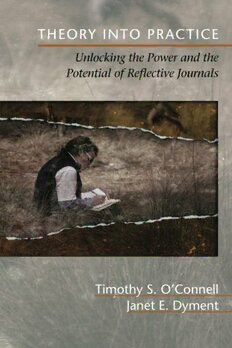Table Of ContentTheory Into Practice
Unlocking the Power and the
Potential of Reflective Journals
Theory Into Practice
Unlocking the Power and the
Potential of Reflective Journals
Timothy S. O’Connell
Brock University
Janet E. Dyment
University of Tasmania
INFORMATION AGE PUBLISHING, INC.
Charlotte, NC • www.infoagepub.com
Library of Congress Cataloging-in-Publication Data
O’Connell, Timothy S., 1968-
Theory into practice : unlocking the power and the potential of reflective
journals / Timothy S. O’Connell, Brock University; Janet E. Dyment,
University of Tasmania.
pages cm
Includes bibliographical references.
ISBN 978-1-62396-150-3 (pbk.) -- ISBN 978-1-62396-151-0 (hardcover) --
ISBN 978-1-62396-152-7 (ebook) 1. Diaries--Authorship. I. Dyment, Janet
E. II. Title. III. Title: Unlocking the power and the potential of
reflective journals.
PN4390.O28 2013
808.06’692--dc23
2012045815
Copyright © 2013 Information Age Publishing Inc.
All rights reserved. No part of this publication may be reproduced, stored in a
retrieval system, or transmitted, in any form or by any means, electronic, mechanical,
photocopying, microfilming, recording or otherwise, without written permission
from the publisher.
Printed in the United States of America
Contents
About the Authors ..........................................................................ix
Acknowledgements ........................................................................xi
Preface .........................................................................................xiii
Foreword .....................................................................................xvii
1 Background Information ................................................................1
Journal or Diary? ..............................................................................2
History of Journal Writing ...............................................................4
Types of Journals ...............................................................................9
Other Types of Journals .................................................................20
Conclusion .......................................................................................22
2 Benefits of Journaling ..................................................................23
Benefits for the Student ..................................................................24
Benefits for the Educator ...............................................................28
Conclusion .......................................................................................32
3 The Challenges of Journal Writing ................................................33
Handed a Blank Journal: No Training/No Structure .................34
Writing for the Teacher ..................................................................35
Journaled to Death .........................................................................36
Annoying Busy Work ......................................................................37
Does Not Suit All Students .............................................................39
Gender .............................................................................................40
Ethics: Blurring of Personal and Professional Realm ..................42
Assessment .......................................................................................43
v
vi Contents
Keeping up with the Times ............................................................45
Conclusion .......................................................................................47
4 Theoretical Aspects of Journaling ................................................49
Reflection ........................................................................................50
Dewey’s Process of Experiential Learning ....................................50
Kolb’s Experiential Learning Theory ...........................................52
A Focus on Reflection as Part of Learning ...................................55
Scanlon and Chernomas .................................................................55
Kember et al. ...................................................................................56
Schon .............................................................................................57
Bloom’s Taxonomy ..........................................................................58
The “ICE” Approach .......................................................................60
Articulated Learning ......................................................................60
Valli’s Typology ...............................................................................61
Some Final Thoughts on Models of Reflection ..................................62
What the Research Has to Say About Journal Writing ................62
Perceptions of Journals ....................................................................63
Quality of Reflection .......................................................................65
Journal Implementation ..................................................................67
Conclusion .......................................................................................71
Notes ................................................................................................72
5 Supporting Students to Journal Successfully ................................73
What Inhibits Reflection and Good Journal Writing ...................74
Strategies for Encouraging Deeper Reflection
and Better Journals ..................................................................76
Journal #1: Introduction to Outdoor Education ..........................88
Journal #2: Outdoor Environments ..............................................90
Journal #3. Outdoor Journeys .......................................................91
Conclusion .......................................................................................93
Notes ................................................................................................94
6 Encouraging Creativity .................................................................95
Being Creative—Graphic Entries ..................................................96
Style Ideas—Creative Approaches to Writing Differently .........101
Add-Ins—Imaginative Items to Supplement Journal Entries .....110
Conclusion ......................................................................................116
Notes ...............................................................................................116
Contents vii
7 Responding to and Assessing Journals ........................................117
Responding to Journals .................................................................118
Benefits of Good Responses ........................................................118
Challenges of Responding ...............................................................118
Who Responds? ............................................................................120
Types of Response ..........................................................................123
Levels of Responses .......................................................................123
Assessing Journals .........................................................................128
Benefits of Assessing ......................................................................128
Challenges of Assessing .................................................................129
High Stakes, Low Stakes, or Good Enough Writing ........................133
Standards and Criteria for Assessment ..........................................134
Conclusion .....................................................................................144
8 Technology and Journals .............................................................145
Tools and Applications for Capturing Reflections .....................146
Tools of Digital Reflection .........................................................146
Applications .................................................................................146
How to Choose? ............................................................................148
Opportunities ...............................................................................150
Congruency Between Everyday Life and School Life .......................150
Multiple Forms of Capturing the Moment ......................................151
Immediacy ....................................................................................151
Supports Students as Learners ......................................................152
Portfolios ......................................................................................154
A Pedagogical Framework .............................................................154
Challenges .....................................................................................156
Levels of Reflection .......................................................................156
Retakes and Edits .........................................................................158
Can’t Find the Reflections for All the Bells and Whistles .................158
Allocation of Time and Resources ..................................................159
Instructor Feedback and Responses to Entries .................................159
Public vs. Private? ........................................................................160
Storage and Review ......................................................................160
Conclusion .....................................................................................161
References ...................................................................................163
Appendix: Sample Workshop Outline .........................................171
About the Authors
Timothy S. O’Connell, PhD,
is a full professor in the De-
partment of Recreation and
Leisure Studies at Brock Uni-
versity (Canada). He has been
a professor for 12 years and
involved in outdoor recreation
and outdoor education for over
20 years. He lives in Ontario,
Canada.
Janet E. Dyment, PhD, is a se-
nior lecturer in the Faculty of
Education at the University of Tasmania (Australia). She has worked in
higher education for 12 years and been involved with outdoor education
for over 20 years with organizations such as the Outward Bound Canada.
She currently lives in Tasmania, Australia.
Tim and Janet met while working at the School of Outdoor Recreation,
Parks and Tourism at Lakehead University in Thunder Bay, Ontario (Cana-
da). Together they’ve conducted research and written extensively on using
reflective journals in higher education settings.
Unlocking the Power and the Potential of Reflective Journals, page ix
Copyright © 2013 by Information Age Publishing
All rights of reproduction in any form reserved. ix

